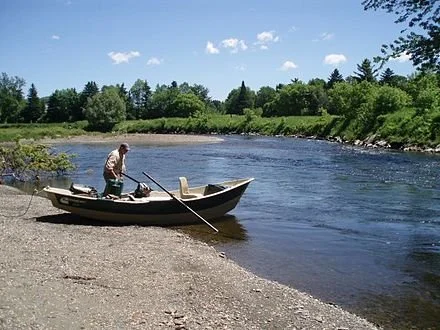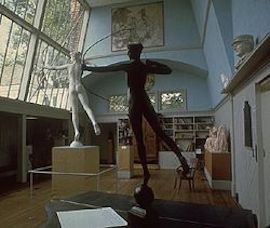
Riverine review
A visitor walks through work in the group show "One River, Many Views," at Saint-Gaudens National Historical Park, in Cornish, N.H., through Oct. 30.
— Photo Courtesy Saint-Gaudens National Historical Park
The park says:
“One River, Many Views’’ features the work of Nancy Diessner (Mass.), Brenda Garand (N.H.), and Janet Pritchard (Conn.), whose work responds to the Connecticut River’s beauty, its power and its history. These artists work in a variety of media, including photography, drawing, printmaking and sculptural forms, at times using the river water, its soil and its flora as part of their art-making process. In addition to the artwork, the show features commissioned wall labels written by 10 members of the Upper Valley community who live in, work in and otherwise engage with the Connecticut River. These include creative writers, scholars and simply residents, as well as those from the indigenous, agricultural, recreational and other communities for whom the river is an important part of their daily lives. Their responses – reflective, celebratory, or interrogatory — will highlight the diverse natural and cultural histories and relationships with this imposing body of water. The exhibition seeks to encourage discussion as well as awareness of the ways that one topic can hold multiple approaches, opinions, expertise, and experiences.’’
Drift boat fishing guide preparing to work the river near Colebrook, N.H.
'A wingless angel'?
The Robert Gould Shaw Memorial, at Boston Common. A reproduction can be found at the Saint Gaudens National Historical Park, in Cornish, N.H. (the town in which the late famously reclusive writer J.D. Salinger lived for many years).
“….A month ago,
at Saint-Gaudens’s house, we ran from a startling downpour
into coincidence: under a loggia built
for performances on the lawn
hulked Shaw's monument, splendid
in its plaster maquette, the ramrod-straight colonel
high above his black troops. We crouched on wet gravel
and waited out the squall; the hieratic woman
-- a wingless angel? -- floating horizontally
above the soldiers, ‘‘
—- from “Demolition,’’ by Mark Doty
The Saint-Gaudens National Historical Park preserves the home, gardens and studios of Augustus Saint-Gaudens (1848–1907), one of America's most famous sculptors. The estate was his summer residence in 1885-1897, and then his permanent home from 1900 until his death. It was the center of the Cornish Art Colony. The estate includes two hiking trails. Original sculptures are on exhibit, along with reproductions of his masterpieces.
Allegedly, there were wild parties when Saint Gaudens was in residence.
One of the statues at the park
Skiing and snowshoeing at the park.
On Jan 4 10-11:30 a.m., follow a ranger at the park for a stroll through history around its grounds.
Salinger's high country
Statues at the wonderful Saint Gaudens National Historic Site, in Cornish, N.H., where J.D. Salinger lived for decades, though he remained in many ways a Manhattanite.
Herewith a charming look in The Boston Globe at J.D Salinger's Connecticut River Valley section of Vermont and New Hampshire. I have always found it one of the loveliest and most interesting parts of America.
I took a class in Chinese history with his wife of the time -- the '60s --- Claire Douglas, at Dartmouth. The young assistant professor seemed very smitten with this beautiful lady. Toward the end of the trimester, I was surprised that at a social gathering (at the professor's apartment) for the class, which only had about a dozen people, that the majority of the attendees (including the professor) supplemented their wine and beer with marijuana cigarettes. This was the high '60's indeed!
-- Robert Whitcomb
Diner rises after Irene
A typical small New England town diner goes on as Wilmington, Vt.'s informal community center after being repaired after devastating flooding by Tropical Storm Irene. Those high carbohydrate and animal-fat breakfasts may not make your body thrive, but your soul and social life get much sustenance.
These diners can be very friendly places but the staff and customers know when to leave people alone, too. Take the Windsor Diner, in Windsor, Vt. The great celebrity recluse J.D. Salinger, who lived just across the river in Cornish, N.H., frequently patronized the place; everyone left him alone.







